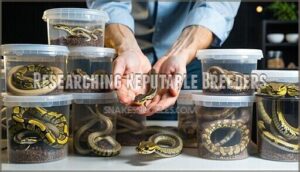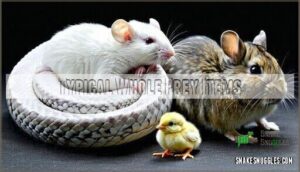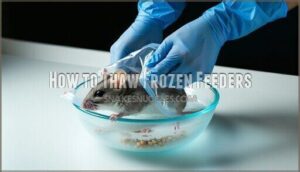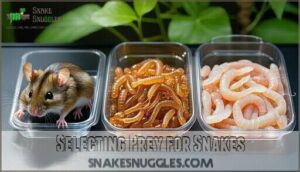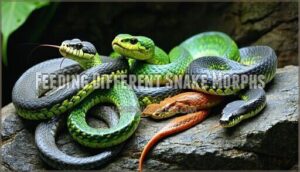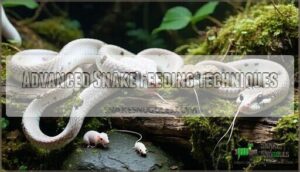This site is supported by our readers. We may earn a commission, at no cost to you, if you purchase through links.

Ball pythons, corn snakes, and other popular morphs each require different prey sizes and feeding schedules.
You’ll want to feed frozen-thawed rodents that match your snake’s girth – typically every 5-14 days depending on age and species.
Research your morph’s temperament since some are pickier eaters than others.
Start with what your breeder was feeding and gradually switch if needed.
Proper prey sizing prevents regurgitation while maintaining healthy growth rates.
Temperature and humidity during feeding also impact success rates, especially with finicky morphs that might refuse meals in suboptimal conditions.
Table Of Contents
- Key Takeaways
- Choosing Right Snake Morph
- Snake Feeding Basics
- Selecting Prey for Snakes
- Feeding Different Snake Morphs
- Advanced Snake Feeding Techniques
- Specialized Diet and Feeding
- Frequently Asked Questions (FAQs)
- How much should a 500 gram ball python eat?
- What is the best enrichment for snakes?
- What do assorted king snake morphs eat?
- How often should I feed my snake morph during breeding season?
- Can different morphs eat the same prey items safely?
- What supplements are needed for specific snake morphs?
- How does feeding frequency change with morph genetics?
- Conclusion
Key Takeaways
- Match prey size to your snake’s girth – you’ll prevent regurgitation by feeding prey that’s 1.0-1.5x your snake’s thickest body section, regardless of the morph’s color pattern
- Stick to frozen-thawed rodents over live prey – you’ll reduce injury risks and stress while maintaining proper nutrition, with most morphs adapting within weeks using scenting techniques
- Follow species-specific feeding schedules, not morph genetics – you’ll feed hatchlings every 5-7 days, juveniles weekly, and adults every 10-14 days based on age and size, not color patterns
- Research your breeder’s current feeding routine before switching – you’ll avoid feeding problems by gradually transitioning from their established diet rather than making sudden changes that create picky eaters
Choosing Right Snake Morph
Selecting the right snake morph sets the foundation for successful reptile keeping and directly impacts your feeding experience.
You’ll want to balance your aesthetic preferences with practical considerations like temperament, care requirements, and local regulations before making your choice.
Researching Reputable Breeders
Smart shopping starts with solid research—you’ll thank yourself later when your snake thrives. Reputable breeders with transparent practices and proper licensing create healthier morphs with better genetics.
Check state regulations for exotic permits before falling in love with any snake.
- Verify breeder licensing: Look for USDA licenses, Reptile Industry Association codes, and local animal welfare certifications
- Examine health guarantees: Top breeders offer live arrival guarantees and multi-week health warranties with 90%+ fulfillment rates
- Review breeding genetics: Established breeders provide detailed genetic lineage for three or more generations, reducing inbreeding risks
- Check transparent practices: Legitimate sellers maintain visible certifications, quarantine protocols, and traceable transaction records on platforms like MorphMarket
Understanding Morph Prices
How much should you budget for that stunning ball python morph?
Snake morph prices vary dramatically based on genetic traits and rarity influence.
Entry-level morphs like Yellow Belly cost $65-75, while rare varieties reach $30,000+.
Morph demand drives investment potential—new morphs drop 80% in five years as supply increases.
Breeder reputation affects pricing alongside market availability and shipping costs.
Enclosure costs can range from $70 to $450 depending on size.
Considering Temperament
Beyond pricing considerations, temperament shapes your snake morphs feeding success and handling experience.
Your chosen species’ docility directly impacts both daily care routines and children safety.
Consider these temperament factors when selecting beginner snakes:
- Morph aggression varies substantially between species and individual animals
- Handling frequency tolerance differs among snake temperament types
- Species docility affects your snake feeding guide success rates
- Children safety depends heavily on predictable, calm snake diet behaviors
Ball pythons typically offer gentle temperaments perfect for new keepers, while corn snakes provide consistent docility.
Ball pythons and corn snakes make perfect starter snakes for beginners seeking docile, manageable pets.
Research specific morph lines, as some breeding practices can influence aggression levels and stress responses during feeding times.
Location and Laws to Consider
Before owning snake morphs, you must research state regulations and exotic permits in your area.
Ball pythons face bans in Hawaii and some NYC municipalities, while local ordinances may restrict certain morphs due to invasive species concerns.
Import restrictions limit overseas purchases, and breeder licensing requirements vary by location.
Violating these legal considerations can result in fines up to $5,000 or animal confiscation.
Snake Feeding Basics
Feeding your snake properly starts with understanding what they’re already eating at the breeder or store.
You’ll need to master the basics of prey preparation and switching techniques to keep your morph healthy and thriving, which involves understanding the complete concept of snake feeding and care.
What Does Your Breeder or Store Currently Feed
Before you start feeding your new snake, ask your breeder or pet store what they’re currently feeding it.
Snakes can become finicky eaters when you switch their current diet too quickly. Understanding their existing snake feeding routine helps prevent feeding problems.
Some morphs get used to specific prey items, making switching prey difficult later.
Getting this information upfront makes your snake diet change smoother.
How to Switch From Live to Frozen Feeders
Adaptation challenges arise when switching your snake from live to frozen feeders, but patience makes the difference. Most snakes adapt within weeks using proper scenting techniques and gradual introduction methods.
Many owners source their frozen snake feeders from online retailers.
- Mimic live prey scents by rubbing frozen feeders with bedding from live rodent cages
- Warm feeders thoroughly in sealed bags using warm water for 15 minutes
- Use movement techniques by wiggling prey with tongs to trigger feeding response
- Maintain ideal temperatures in the enclosure during feeding attempts
- Handle refusal calmly by waiting 7-10 days before trying again with scenting
Typical Whole Prey Items
Your snake’s menu isn’t limited to just mice. Rodent nutrition varies between mice, rats, and occasional rabbits for larger morphs.
Prey diversity prevents nutritional deficiencies while supporting healthy growth. Some keepers use insect gut-loading for smaller species, though whole rodents remain the gold standard.
Remember, feeder size directly impacts your snake’s health and digestion success.
How to Thaw Frozen Feeders
Proper thawing prevents bacteria growth and nutritional loss in frozen snake food. Never use microwaves, which destroy nutrients and create hot spots that burn your snake’s mouth.
Skip the microwave—it creates dangerous hot spots that can burn your snake’s mouth.
Frozen food also offers reduced injury risks compared to live prey.
- Place frozen feeder in sealed bag, submerge in warm water for 15 minutes
- Check that prey feels squishy and reaches hand-comfortable water temperature
- Use rubber-tipped tongs for safe handling during snake feeding sessions
Cold feeders harm digestion since snakes can’t regulate body temperature. Never refreeze thawed items.
Selecting Prey for Snakes
Selecting the right prey for your snake involves matching food size to your pet’s girth and understanding their natural feeding preferences.
You’ll need to evaluate factors like prey availability, nutritional content, and your snake’s individual feeding response to guarantee healthy growth and development.
Factors to Consider When Selecting Snake Food
Several key factors determine the right snake food choice for your pet.
Snake size and age directly impact prey requirements – younger snakes need smaller prey items while adults require larger options.
Nutritional content varies between prey types, affecting your snake’s health.
Consider prey source reliability and ethical concerns when choosing suppliers, as different snake morphs may have specific dietary needs within your snake feeding guide.
Snake Prey Selection Common Options
Most snake keepers choose rodents as their go-to prey items. Mice and rats offer excellent rodent nutritional value and come in various sizes.
You’ll find prey item variety includes frozen-thawed options (safer than live vs frozen alternatives) and different species like quail or chicks. Many keepers source their snake frozen feeders online for convenience.
Follow prey size guidelines matching your snake’s girth. Scenting prey items helps picky eaters accept new snake food types for ideal snake diet success.
Why Size Matters in Snake Diet
Getting prey size wrong can spell disaster for your snake’s health.
Feeders should match 1.0-1.5x your snake’s thickest body part – anything larger risks regurgitation and digestive issues.
Oversized prey creates nutritional imbalances and obesity prevention problems.
A proper snake feeding chart helps you nail feeder sizing every time, ensuring your morph thrives without dangerous complications.
It’s also important to keep in mind the snake’s head width capacity when selecting prey, to prevent issues like digestive issues and ensure a healthy diet for your snake’s health.
Feeding Different Snake Morphs
Different snake morphs have unique feeding needs that you should understand before bringing your new pet home.
Each morph comes with specific dietary requirements, from prey size preferences to feeding schedules that keep them healthy and thriving.
Ball Python Feeding Requirements
Ball pythons need precise feeding to stay healthy. Your snake’s body weight determines portion size – aim for prey totaling 10% of their weight.
Adults eat every 10-14 days, while juveniles need weekly meals.
Key feeding guidelines for ball pythons:
- Hatchlings (under 100g): Crawler mice every 4-5 days
- Juveniles (100-500g): Weaned mice weekly
- Adults (800g+): Adult mice every 10-14 days
Frozen-thawed rodents beat live prey for safety. Live feeders can injure your snake and cause stress.
Morph-specific needs don’t change basic requirements, but watch for obesity prevention in sedentary morphs. Overfeeding leads to regurgitation risks.
Note appropriate prey sizes to prevent regurgitation and stress.
Corn Snake Feeding Requirements
Corn snakes adapt well to consistent feeding schedules.
Hatchlings need pinky mice every 5-7 days, while juveniles eat weaned mice weekly.
Adult portions should match your snake’s girth—oversized prey causes regurgitation risks.
Adults feed every 14-21 days, preventing obesity.
Monitor weight monthly and adjust feeding frequency accordingly for ideal health.
Leopard Gecko Feeding Requirements
How do you feed leopard geckos properly? Unlike snakes, these spotted beauties need live insects and frequent meals.
- Feeding frequency: Juveniles eat daily, adults need food 2-3 times weekly
- Portion control: Two insects per inch of body length prevents obesity
- Insect gut-loading: Feed crickets nutritious food before offering them to baby geckos
- Calcium dusting: Coat insects with phosphorus-free powder for strong bones
This reptile feeding guide emphasizes hydration methods and proper reptile nutrition for ideal leopard geckos health.
Snakes, however, require a 2:1 calcium ratio to prevent metabolic bone disease.
Advanced Snake Feeding Techniques
Once you’ve mastered basic feeding, advanced techniques can solve common challenges and optimize your snake’s health. These methods help with picky eaters, multiple snake management, and creating ideal feeding conditions.
Prey Enrichment and Scenting
Scenting techniques transform picky eaters into enthusiastic feeders by rubbing prey with preferred scents like frog bedding or chicken broth.
This nutritional variety approach mimics natural hunting while providing live prey alternatives.
You’ll notice increased tongue flicks and behavioral responses when combining movement with scenting.
Many keepers find success using a reptile scent attractant to entice feeding.
These enrichment benefits encourage natural snake feeding behavior, making feeding techniques more effective and reducing stress during prey presentation.
Assist Feeding and Managing Multiple Snakes
Assist feeding carries serious Force-feeding Risks and should only occur under veterinary guidance when snakes refuse meals for extended periods.
When managing multiple snakes, establish strict Quarantine Protocols and separate Feeding Schedules to prevent Competition Avoidance issues.
House snakes individually since Group Housing creates stress and territorial disputes. Adequate enclosure space is also critical when considering housing multiple snakes.
These snake feeding tips guarantee safer snake care while addressing snake feeding problems through proper feeding techniques and careful snake handling practices.
Creating a Thermal Gradient for Feeding
Temperature control transforms snake feeding success.
Set your basking temperature at 88-92°F with cool zones at 75-80°F using reliable heat sources.
This thermal gradient helps snakes digest properly after meals.
Monitor gradient monitoring regularly to match species needs.
Your snake enclosure’s temperature stability directly impacts feeding response and digestive health.
Specialized Diet and Feeding
Once you’ve mastered basic feeding, certain snake morphs require specialized diets that go beyond standard mice and rats.
Understanding these unique nutritional needs guarantees your snake thrives and displays its full genetic potential.
Western Hognose Snake Diet and Feeding
Western Hognose Snake (Heterodon nasicus) feeding requires understanding their carnivorous diet and specific prey preferences.
You’ll find success matching their natural hunting instincts with proper feeding schedules and prey sizing.
- Hognose prey types: Pinky mice for hatchlings, adult mice for mature snakes
- Feeding frequency: Every 5-7 days for juveniles, 10-14 days for adults
- Obesity prevention: Monitor weight, avoid oversized prey items exceeding snake’s girth
Varied Diet for Snake Morphs
Beyond rodents, you’ll boost your snake’s health with prey rotation.
Different food sources prevent nutritional gaps while supporting natural behaviors.
Some morphs with metabolic issues need varied protein content for ideal growth.
| Prey Type | Nutritional Benefit | Best For |
|---|---|---|
| Mice/Rats | Balanced baseline nutrition | All snake morphs |
| Birds (quail/chicks) | Higher protein content | Slower growth morphs |
| Fish (whole) | Essential fatty acids | Obese snakes |
| Multiple prey sizes | Prevents feeding strikes | Finicky eaters |
Your snake diet plan should match wild feeding patterns.
Offering variety keeps snakes mentally engaged and physically healthy through balanced snake nutrition.
Prey Size and Feeding Schedule for Snakes
Matching prey size to your snake’s girth prevents regurgitation risks and supports obesity prevention.
Hatchling schedules require feeding every 5-7 days, while adult frequency drops to 10-14 days.
Your snake feeding schedule should include weight monitoring to adjust portions.
Proper prey size equals 1.0-1.5x your snake’s thickest body section for ideal feeding frequency and snake diet plan success.
Frequently Asked Questions (FAQs)
How much should a 500 gram ball python eat?
Feed your 500-gram ball python like clockwork—50 to 75 grams of prey works perfectly. That’s typically one adult mouse every 10-14 days, matching 10-15% of their body weight for ideal health.
What is the best enrichment for snakes?
You’ll want to create a stimulating environment using hiding spots, climbing branches, different textures, and occasional supervised exploration outside their enclosure to keep your snake mentally engaged.
What do assorted king snake morphs eat?
Like a diverse buffet, king snake morphs enjoy identical menus regardless of their stunning patterns.
You’ll feed them appropriately sized frozen-thawed mice or rats every 7-14 days, matching prey width to your snake’s thickest body section.
How often should I feed my snake morph during breeding season?
During breeding season, you’ll want to increase feeding frequency slightly.
Adult snakes typically eat every 10-14 days normally, but bump it to every 7-10 days when breeding to support their increased energy needs.
Can different morphs eat the same prey items safely?
Yes, different morphs of the same species can safely eat identical prey items. The morph affects appearance, not dietary needs. Match prey size to your snake’s girth regardless of coloration.
What supplements are needed for specific snake morphs?
Most snake morphs don’t need special supplements, but certain ones do.
Spider and Enigma ball pythons benefit from calcium supplementation due to neurological issues.
Scaleless morphs may need vitamin D3 since they absorb less UV light through their skin.
How does feeding frequency change with morph genetics?
Feeding frequency doesn’t change based on morph genetics alone.
You’ll feed according to your snake’s age, size, and species—not its color pattern.
Genetics affect appearance, not metabolism or digestion rates.
Conclusion
Mastering the best snake feeding guide morphs isn’t rocket science—it’s about consistency and observation.
You’ve learned proper prey sizing, feeding schedules, and morph-specific requirements that’ll keep your snake thriving.
Remember to monitor your snake’s body condition, adjust feeding frequency as they grow, and don’t panic if they occasionally refuse meals.
Whether you’re feeding ball pythons, corn snakes, or hognose morphs, these fundamentals will serve you well throughout your snake-keeping journey, and always keep in mind the importance of observation.
- https://a.co/d/29jLEJv
- https://www.xyzreptiles.com/how-much-does-a-ball-python-cost/
- https://snakeinsider.com/how-much-is-a-corn-snake/
- https://timesofindia.indiatimes.com/etimes/trending/10-expensive-snakes-in-the-world-including-green-tree-python-sunset-ball-python-and-more/articleshow/117973509.cms
- https://community.morphmarket.com/t/pricing-of-snakes/34658

